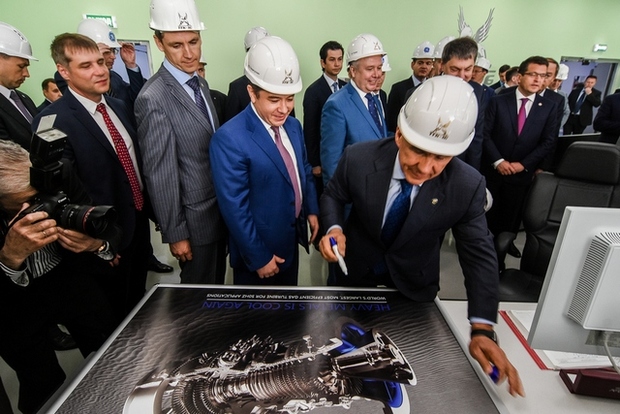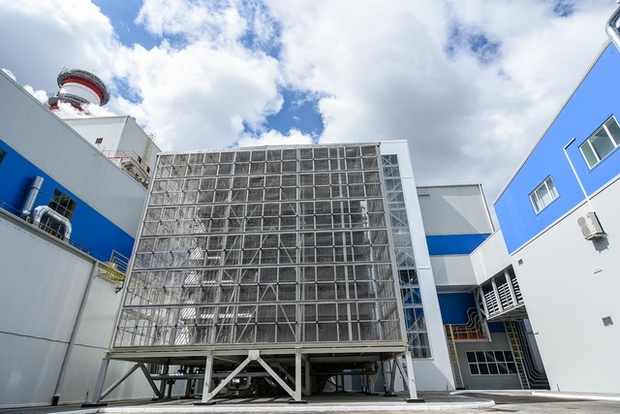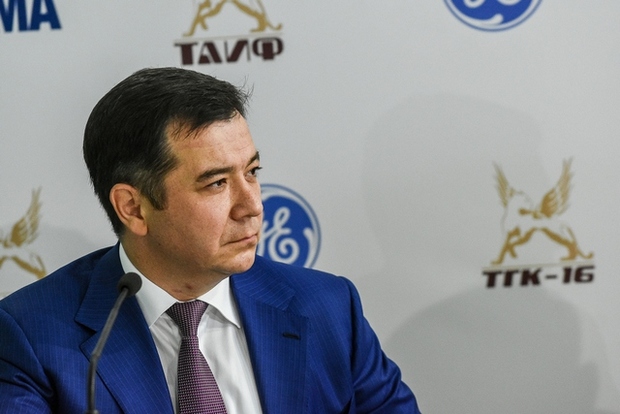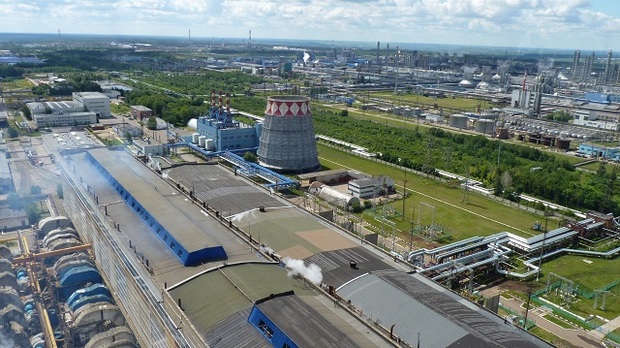To double capacity: industrial update ends in Kazan CHPP-3
An important event took place in power engineering of Tatarstan these days – integrated update of one of the oldest power plants of the republic – Kazan Combine Heat and Power Plant-3 – ended. The process had several stages. The launch of a new energy unit with a capacity of 405,6 MW at 14bn rubles was the biggest and final element. In general, there are five such units based on 9HA.01 hi-tech gas turbine in the world. Kazan became the first energy site in Russia and second in the world where such a project was carried out. The facility that is strategically important for the capital of Tatarstan is going to become one of the departing points while creating a 220 kW Kazan energy ring that is designed to solve the problem with deficient electricity in the city. Industrial enterprises, houses and social facilities will be provided with electricity and heat for many years ahead.
€535 for construction of 1 kW of installed capacity
Tatarstan's energy company TGC-16 PJSC ended an integrated update of the biggest Kazan CHPP-3. The process included several stages. Measures aimed to provide reliability of electricity and heat energy production took place first. Then an integrated reconstruction and update of the power plant in order to increase the efficiency and competitiveness of energy generation began. Construction of an energy unit based on 9HA.01 unique gas turbine was the biggest event. Today Russia doesn't have analogues of this turbine. Its launch became the final chord of the integrated modernisation programme of the Kazan CHPP-3 that began almost immediately after purchasing the plant by TAIF as property.
The power generating unit whose capacity is 405,6 MW today was put into operation by Tatarstan President Rustam Minnikhanov at the beginning of the last week. Mayor of Kazan Ilsur Metshin, Vice-Chairman of American General Electric John Rice, TAIF PJSC Director General Albert Shigabutdinov and others took part in the launching ceremony.
''It is the biggest gas turbine unit in our country. And today it exceeded all the terms of the contract in all its results after launching. 400 MW of capacity will appear in Kazan, imagine! It is a very serious step and good example,'' the Tatarstan president noted.

The story of the erection of the unit began in April 2014 when an agreement between TGC-16 PJSC and General Electric's subsidiary GE Rus PLC on update of the Kazan CHPP-3 with turnkey construction was signed. The construction was going to take place within international partnership. GAMA, a Turkish engineering and construction company, was included besides General Electric.
The power plant's modernisation programme presupposed achievement of four major goals. Firstly, it was important to provide energy reliability of both industrial enterprises and population of Kazan. It especially referred to first-category consumers of energy supply reliability – industrial enterprises. Secondly, it was necessary to increase electricity generation at least two times based on current energy consumption to cut the deficit of energy in Kazan. What is more, it was important not only conserve but increase heat generation maintaining reasonable heat energy tariffs for industrial consumers and the population. Another task was to reduce brake specific fuel consumption used by the plant to generate electricity. So it would raise its competitiveness in the wholesale electricity market and capacities. ''Now we can say TGC-16 accomplished all the tasks that TAIF had set,'' Deputy Director General of TAIF on Power Engineering and IT Ruslan Gizzatullin.

Thanks to a systematic work, construction of one 1 kW of installed capacity made up €535, Rustam Minnikhanov noted
''The project needs to be considered together with the existing plant. Thanks to a systematic work, construction of one 1 kW of installed capacity made up €535. It is a very good digit for the economy. The gas turbine unit is two times more efficient than existing energy units. Everybody understands that we need to supply electricity to the wholesale electricity market. We have capacities, but we are not rivals and not always are able to sell our energy. The capacities we are going to have now will be in demand. In this case, we have a great chance to be in the market always,'' Rustam Minnikhanov expressed perspectives after the official launch of the gas turbine unit. Knowing that many energy market experts claimed many times that it was important to launch new energy capacities based on combined cycle gas turbine technologies cheaper than €1,300 per kW in the current conditions, we can completely realise the importance of the project.
14bn rubles for unique project
Major works on construction of the new energy unit began at the end of summer in 2015 when permission was obtained in the Executive Committee of the city. Earlier only preparation took place on the construction site and the equipment was manufactured in factories around the world. For instance, 9HA.01 gas turbine was made in a factory of GE in Belfort (France), the generator was manufactured in Schenectady (the USA), the waste-heat boiler – in South Korea.
Delivery of the made equipment to the construction site became another landmark in the history of the energy unit construction. The big-size equipment was delivered by sea from the producer to Saint Petersburg's port, then to Lake Lagoda via The Volga to Zelenodolsk. A temporary mooring was built near the railway bridge through The Volga in Zelenodolsk, dredging works took place, the route of the freight from Zelenodolsk to the Kazan CHPP-3 was created, the road was improved where the equipment would be delivered on to receive, unload and shipping of the delivered equipment.
In general, they managed to erect the energy unit within 1,5 years. According to TAIF PJSC Director General Albert Shigabutdinov, the project totalled 14bn rubles. ''We spent 300 grammes of brake fuel to generate 1 kW. Now less will be spent – 200 grammes. I think due to the parameters of the turbine's characteristics, we will be able to pay the project back within acceptable terms. It is very reliable energy supply for Kazanorgsintez,'' Albert Shigabutdinov stressed.

Commissioning and start-up began in the plant at the beginning of April this year. Then it became clear the installed capacity mentioned in the contract, which was to make up 388,6 MW first, was going to be more. In answer to a question of Realnoe Vremya's reporter how they managed to achieve big indicators than expected, GE Vice-Chairman John Rice said, first of all, it was explained by heat balance. As Mr Rice commented on the increase of indicators, this project would not be possible without close cooperation with all the participants: TAIF Group of Companies, contractor general GAMA and technical experts. The equipment runs very high speeds and has high temperatures. It is necessary to configure the cooling system in a correct way to enable the turbine to show the biggest efficiency. It was also important to use modern materials that could withstand temperatures particularly in blades, spray nozzles to exploit the turbine at a temperature that was chosen.
Second departing point in Kazan energy ring
One of the most important and responsible operations of the energy launch took place in the gas turbine unit in the second half of March, on 19 March: the generator was turned on as test. The turbine was put into operation in May. By that time, its indicators reached 405,6 MW of electricity capacity and 455 Gcal/h of heat capacity. The electricity generated by the gas turbine power unit was sold in the wholesale energy market during the trials and test work.
The end of construction and launch of the turbine marked a complete end of the modernisation in the Kazan CHPP-3. So the plant became the second basic point while creating the 220 kW ring around Kazan.
The energy ring presupposes that three sources will become energy centres of the city – Kazan CHPP-3, Kindern substation and Central substation. Kindery substation has always been an energy centre of Kazan. It is linked with the single energy system of Russia and is one of the energy centres – Zainsk State Regional Power Plant with 500 kW networks. A new generation scheme of the Kazan CHPP-3 will enable to send 220 kW to the network– all its capacity without restrictions including from the new gas turbine unit of the Kazan CHPP-3. The 220 kW network is to reach the third source — Central substation – from 500/200 kW Schelokov substation in autumn. All the three sources are linked with 220 kW networks between each other. The networks can send emergency capacity in case of a local deficit or shutdowns. It means the population and industrial enterprises will have a reliable energy supply.

The new energy unit will allow the Kazan CHPP-3 to reduce the deficit of electricity capacity in the Kazan Energy District. As it is known, it is big. The lack of capacity is 650-850 MW here. Today about 70% of the electricity of Kazan is supplied from outside.
Capacity of KCHPP-3 to double
''Flexibility is an advantage of this unit,'' Deputy Director General of TAIF PJSC on Power Engineering and IT Ruslan Gizzatullin told about peculiarities of the turbine. According to him, quick start, quick load increase, high reliability and high efficiency are key indicators for power engineering. ''The capacity of the power plant will almost double, now it will be equal to 790 MW,'' Gizzatullin emphasised.
The unique turbine will be connected with already existing steam turbine equipment of the power plant. Thanks to it, the CHPP will generate electricity and heat in a steam and gas cycle as a result of using the gas turbine unit because the heat of exhaust fumes will be used in the waste-heat boiler. Generating superheated steam, the boiler will go to the plant's header and launch existing steam turbines.

The capacity of the power plant will almost double, now it will be equal to 790 MW
We should also note the high flexibility in use is among the turbine's advantages that is achieved thanks to the use of an innovative modular management system, which, in turn, enables to launch the unit quickly, switch to a partial load and maintain high-efficiency indicators. And the presence of a low-emission burner will allow the Kazan CHPP-3 to considerably reduce emissions into the environment. ''Like all the new factories at TAIF Group of Companies, the turbine is ecologically pure. It is almost a green turbine,'' Ruslan Gizzatullin noted.
Own power engineering from scratch
We should remind that the Kazan CHPP-3 was founded in 1964 and is the biggest plant in the city. The plant was put into operation in 1968. Next year it will celebrate its 50 th jubilee. Together with the Nizhnekamsk CHPP, the KCHPP-3 was part of Generating Company PJSC (Tatenergo AO today) until 2010. Then it was purchased by TAIF Group of Companies' TGC-16 energy company that was recreated.
The goals of the purchase of energy assets were quite clear and almost on the surface. Emergency stoppages of productions because of failures in heat and electricity supply in enterprises of the energy system took place in factories every year. At the same time, TAIF Group enterprises consumed 50% of generated heat in total and provided 80% of heat sales income with waste steam from Generating Company PJSC power plants, which was part of Tatenergo PJSC. Heat tariffs were so high that the share of costs on energy resources in comparison with the prime cost of final products of petrochemical enterprises was over 25%. With such a structure, it was not possible to think about the competitiveness of Tatarstan petrochemical enterprises in the world market. To compare, the share of expenditures on energy resources compared to the prime cost of goods of analogous enterprises abroad is no more than 5-8%. ''Things have to change,'' TAIF PJSC Director General Albert Shigabutdinov claimed then at the annual meeting of shareholders in 2009. ''We will create our own power engineering from scratch.''

Officials of the republic interfered in the situation – the energy workers and petrochemists were recommended to solve all the debatable problems without court. First Tatarstan President Mintimer Shaimiev supported the sale of energy assets to the biggest regional companies – TAIF Group and Tatneft Group – to create a competitive energy market in Tatarstan and attract financial resources to modernise the generating capacities. The choice to change the republic's power engineering by selling three power plants of Generating Company PJSC to biggest industrial consumers, first of all, was caused by the care of regional officials about the population. Construction of own power sources by TAIF Group and Tatneft Group would lead to the closure of operating power plants in Nizhnekamsk and Kazan and unmanageable growth of heat tariffs for the population in these cities. On the other hand, the attempt to conserve the situation with high tariffs for industrial enterprises that arose at that moment would bring to the stoppage of petrochemical and oil refining enterprises, their suspension of heat energy consumption, which would also negatively affect tariffs for the population and the general social and economic situation in the republic. An option that was less effective for new owners from a perspective of capital capacity and payback of invested money but considering, first of all, interests of the population of the Republic of Tatarstan was chosen to handle this difficult situation.
The sale price of the power plants was fixed according to market value carried out by authoritative foreign experts and approved by the government of the republic. The sale of one part of assets of Generating Company PJSC was a mutually beneficial deal because, consequently, the state company spent the collected money on its own investment modernisation programmes of generating capacities including the launch of projects on construction of new modern power units in the Kazan CHPP-1 and CHPP-2.
Having become the owner of assets, TAIF started to create a strategic programme to increase the reliability and efficiency of the energy complex by its complete modernisation that has been successfully performed in the Kazan CHPP-3 in Kazan. The time showed the decision of the regional officials to create independent energy companies was correct. Right this step helped the appearance of strategic investors in Tatarstan's power engineering. For instance, the new owners – Tatneft PJSC and TAIF PJSC – have reconstructed the Nizhnekamsk CHPP-3 and launched a gas turbine unit with a capacity of 405 MW just in the last 2 years. Today the Nizhnekamskneftekhim has been reconstructed. Due to this global reconstruction, now the power plant generates 30% more heat than in 2010. Tatenergo AO has had money to finish the project on a 220 MW Steam and gas unit in the Kazan CHPP-2, the Kazan CHPP-1 is renewed. Such attraction of investments and simultaneous fulfilment of so many projects on the launch of new generating capacities within one company would not be possible.